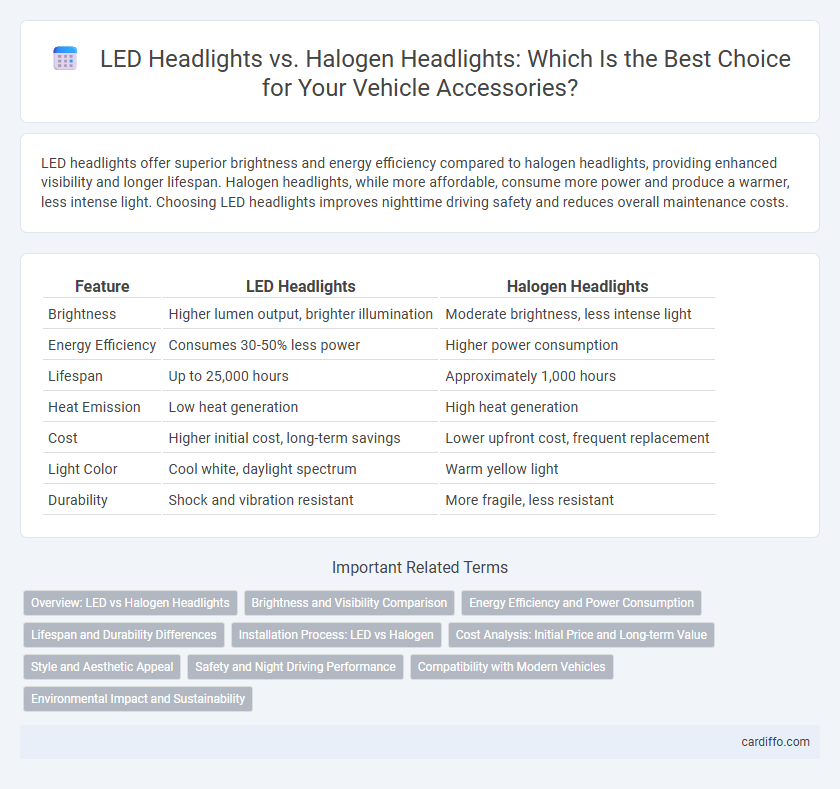LED headlights offer superior brightness and energy efficiency compared to halogen headlights, providing enhanced visibility and longer lifespan. Halogen headlights, while more affordable, consume more power and produce a warmer, less intense light. Choosing LED headlights improves nighttime driving safety and reduces overall maintenance costs.
Table of Comparison
| Feature | LED Headlights | Halogen Headlights |
|---|---|---|
| Brightness | Higher lumen output, brighter illumination | Moderate brightness, less intense light |
| Energy Efficiency | Consumes 30-50% less power | Higher power consumption |
| Lifespan | Up to 25,000 hours | Approximately 1,000 hours |
| Heat Emission | Low heat generation | High heat generation |
| Cost | Higher initial cost, long-term savings | Lower upfront cost, frequent replacement |
| Light Color | Cool white, daylight spectrum | Warm yellow light |
| Durability | Shock and vibration resistant | More fragile, less resistant |
Overview: LED vs Halogen Headlights
LED headlights offer brighter illumination, longer lifespan, and increased energy efficiency compared to traditional halogen headlights. Halogen headlights produce a warmer light with a shorter lifespan and higher energy consumption, making them less efficient for modern vehicles. Vehicle owners often choose LED headlights for improved visibility and reduced maintenance, despite their higher initial cost.
Brightness and Visibility Comparison
LED headlights offer significantly higher brightness levels, measured in lumens, compared to halogen headlights, enhancing visibility on dark roads. With a cooler color temperature around 6000K, LEDs produce a clearer, whiter light that improves contrast and reduces eye strain for drivers. Halogen headlights emit a warmer, yellowish light with lower intensity, resulting in reduced visibility range and less effective illumination in adverse weather conditions.
Energy Efficiency and Power Consumption
LED headlights consume significantly less power, typically around 15-45 watts, compared to halogen headlights which use approximately 55-65 watts. This energy efficiency translates to less strain on the vehicle's electrical system and improved fuel economy. LED technology also offers higher lumen output per watt, providing brighter illumination while conserving battery life.
Lifespan and Durability Differences
LED headlights offer a significantly longer lifespan, typically lasting between 25,000 to 50,000 hours, compared to halogen headlights which generally last around 1,000 to 2,000 hours. The durability of LED headlights is superior due to their solid-state construction, making them more resistant to shock, vibration, and extreme temperatures than halogen bulbs. Halogen headlights, while cheaper initially, tend to wear out faster and require more frequent replacements, impacting long-term maintenance costs.
Installation Process: LED vs Halogen
LED headlights typically require a more complex installation process due to the need for compatible wiring harnesses, drivers, and sometimes additional heat sinks. Halogen headlights offer a straightforward installation, often fitting directly into existing sockets with minimal adjustments. Vehicle-specific connectors and mounting methods can influence installation time and difficulty for both types.
Cost Analysis: Initial Price and Long-term Value
LED headlights typically have a higher initial cost, ranging from $100 to $300 per bulb, compared to halogen headlights, which usually cost between $15 to $50 per bulb. Despite the higher upfront price, LED headlights offer long-term value through improved energy efficiency, longer lifespan of up to 25,000 hours versus 1,000 hours for halogens, and reduced replacement frequency. Over time, the lower maintenance and energy costs of LED headlights make them a cost-effective choice despite the initial investment.
Style and Aesthetic Appeal
LED headlights offer a modern, sleek appearance with crisp, bright white light that enhances vehicle aesthetics and visibility. Halogen headlights emit a warmer, yellowish glow, providing a classic look but often appearing outdated compared to LEDs. Upgrading to LED headlights significantly elevates a car's style, giving it a contemporary and high-tech visual appeal.
Safety and Night Driving Performance
LED headlights offer superior brightness and a whiter light spectrum, enhancing visibility and reducing eye strain during night driving compared to traditional halogen headlights. Their longer range and more focused beam pattern improve reaction times and help detect obstacles or pedestrians earlier, significantly boosting safety. Halogen headlights, while cost-effective, produce a warmer, less intense light that can limit night driving performance and overall road awareness.
Compatibility with Modern Vehicles
LED headlights offer superior compatibility with modern vehicles due to their advanced electrical systems and smart sensor integration, ensuring efficient power consumption and adaptive lighting features. Halogen headlights, while traditional and widely used, often lack the necessary interface for seamless integration with modern vehicle electronics and driver assistance technologies. Automakers increasingly favor LED systems for their enhanced durability, brightness, and ability to adapt to various driving conditions, aligning with contemporary automotive design and safety standards.
Environmental Impact and Sustainability
LED headlights consume significantly less energy and have a longer lifespan compared to halogen headlights, reducing the frequency of replacements and electronic waste. Their lower power consumption decreases vehicle fuel use and emissions, contributing to a smaller carbon footprint. Halogen headlights, while cheaper initially, generate more heat and require more frequent replacements, leading to higher environmental impact over time.
LED Headlights vs Halogen Headlights Infographic

 cardiffo.com
cardiffo.com